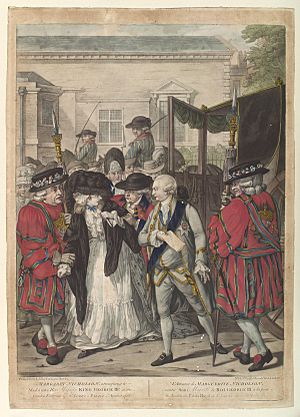Margaret Nicholson facts for kids
Margaret Nicholson (born around 1750 – died May 14, 1828) was an Englishwoman. She became known for an unsuccessful attempt to harm King George III in 1786. This event became famous. It was even featured in one of Shelley's early writings, Posthumous Fragments of Margaret Nicholson, published in 1810.
Contents
Early Life and Work
Margaret Nicholson was born in Stockton-on-Tees, a town in County Durham. Her father was a barber. When she was about 12 years old, she started working as a maid. She worked for several important families, including Sir John Sebright and Lord Coventry. People who knew her said she did not show any signs of mental illness during this time.
Before 1783, she lost her job after some personal difficulties. She then faced tough times. She supported herself by doing needlework, like sewing. She lived in a house on Wigmore Street. People described her as being "below the middle size," meaning shorter than average, and having a "very swarthy complexion," which means a darker skin tone.
The Attack on the King
On August 2, 1786, Margaret Nicholson approached King George III. The King was getting out of his carriage at St. James's Palace. Margaret pretended to give him a petition, which is a formal request. However, the paper was blank. As the King reached for the paper, she quickly tried to stab him twice in the chest. She used a small dessert knife with an ivory handle. People quickly stopped her.
King George III seemed to worry that she would be treated too harshly. He reportedly said, "The poor creature is mad; do not hurt her, she has not hurt me." This showed his calm reaction.
After the Attack
Police searched Margaret Nicholson's home. They found strange letters. In these letters, she claimed she was the rightful heir to the throne. Newspapers at the time thought her mental state was caused by sadness over her personal troubles.
Important officials questioned her. These included Prime Minister William Pitt the Younger and other government leaders. They learned that she had sent letters to the King in July. In these letters, she also claimed to be the rightful ruler. Her landlord said she was hardworking and sober. She earned her living by sewing clothes. Margaret denied wanting to kill the King. She said she only wanted to scare him.
A well-known doctor named Dr John Munro examined her. He confirmed that she was mentally unwell. Because of this, she was sent to Bethlem Royal Hospital. This was a hospital for people with mental illness. She stayed there for the rest of her life and died 42 years later.
King George's Popularity and Security Changes
After the attack, King George III became even more popular. People from all over the country sent him messages of support. They praised his calm reaction and his kind attitude towards someone who was mentally ill. The King himself wrote that he was pleased with how people reacted to the event.
As a direct result of the attack, the King's security was increased. Before, he had 4 guards, but after, he had 11.
How Margaret Nicholson Was Remembered
People had different ideas about Margaret Nicholson. Some saw her as a confused old woman. Others saw her as a romantic figure.
In 1810, Percy Bysshe Shelley and Thomas Jefferson Hogg wrote a book of poems. It was named Posthumous Fragments of Margaret Nicholson. The book pretended to be poems written by Margaret herself. It claimed they were "edited by her nephew, John FitzVictor." However, Margaret was still alive and living in Bethlem Hospital at the time.
Margaret Nicholson was held in the hospital without a formal trial. Some of King George's political opponents criticized this. They said it showed the King was acting like a ruler who ignored the law. However, most people saw it as a kind act by the King. Instead of facing a serious crime charge, she was sent to a hospital.
Later, new laws were made in Britain. These laws helped to formalize how mentally ill people accused of crimes should be treated. This included the idea of being "not guilty by reason of insanity."
In Popular Culture
Margaret Nicholson's attack on King George III is shown in the film The Madness of King George. In the movie, the actress Janine Duvitski played her role.
See also


